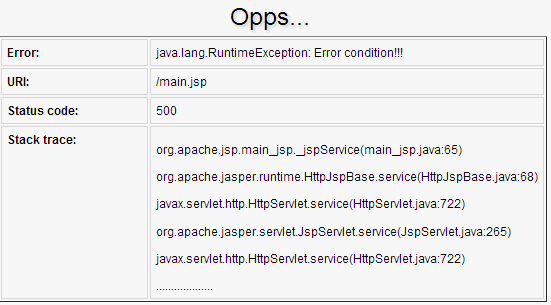# JSP异常处理
当编写JSP程序的时候,程序员可能会遗漏一些BUG,这些BUG可能会出现在程序的任何地方。JSP代码中通常有以下几类异常:
* 检查型异常:检查型异常就是一个典型的用户错误或者一个程序员无法预见的错误。举例来说,如果一个文件将要被打开,但是无法找到这个文件,则一个异常被抛出。这些异常不能在编译期被简单地忽略。
* 运行时异常:一个运行时异常可能已经被程序员避免,这种异常在编译期将会被忽略。
* 错误:错误不是异常,但问题是它超出了用户或者程序员的控制范围。错误通常会在代码中被忽略,您几乎不能拿它怎么样。举例来说,栈溢出错误。这些错误都会在编译期被忽略。
本节将会给出几个简单而优雅的方式来处理运行时异常和错误。
* * *
## 使用Exception对象
exception对象是Throwable子类的一个实例,只在错误页面中可用。下表列出了Throwable类中一些重要的方法:
| **序号** | **方法****&****描述** |
| --- | --- |
| 1 | **public String getMessage()**
返回异常的信息。这个信息在Throwable构造函数中被初始化 |
| 2 | **public ThrowablegetCause()**
返回引起异常的原因,类型为Throwable对象 |
| 3 | **public String toString()**
返回类名 |
| 4 | **public void printStackTrace()**
将异常栈轨迹输出至System.err |
| 5 | **public StackTraceElement \[\] getStackTrace()**
以栈轨迹元素数组的形式返回异常栈轨迹 |
| 6 | **public ThrowablefillInStackTrace()**
使用当前栈轨迹填充Throwable对象 |
JSP提供了可选项来为每个JSP页面指定错误页面。无论何时页面抛出了异常,JSP容器都会自动地调用错误页面。
接下来的例子为main.jsp指定了一个错误页面。使用指令指定一个错误页面。
~~~
<%@ page errorPage="ShowError.jsp" %>
<html>
<head>
<title>Error Handling Example</title>
</head>
<body>
<%
// Throw an exception to invoke the error page
int x = 1;
if (x == 1)
{
throw new RuntimeException("Error condition!!!");
}
%>
</body>
</html>
~~~
现在,编写ShowError.jsp文件如下:
~~~
<%@ page isErrorPage="true" %>
<html>
<head>
<title>Show Error Page</title>
</head>
<body>
<h1>Opps...</h1>
<p>Sorry, an error occurred.</p>
<p>Here is the exception stack trace: </p>
<pre>
<% exception.printStackTrace(response.getWriter()); %>
~~~
注意到,ShowError.jsp文件使用了指令,这个指令告诉JSP编译器需要产生一个异常实例变量。
现在试着访问main.jsp页面,它将会产生如下结果:
~~~
java.lang.RuntimeException: Error condition!!!
......
Opps...
Sorry, an error occurred.
Here is the exception stack trace:
~~~
* * *
## 在错误页面中使用JSTL标签
可以利用JSTL标签来编写错误页面ShowError.jsp。这个例子中的代码与上例代码的逻辑几乎一样,但是本例的代码有更好的结构,并且能够提供更多信息:
~~~
<%@ taglib prefix="c" uri="http://java.sun.com/jsp/jstl/core" %>
<%@page isErrorPage="true" %>
<html>
<head>
<title>Show Error Page</title>
</head>
<body>
<h1>Opps...</h1>
<table width="100%" border="1">
<tr valign="top">
<td width="40%"><b>Error:</b></td>
<td>${pageContext.exception}</td>
</tr>
<tr valign="top">
<td><b>URI:</b></td>
<td>${pageContext.errorData.requestURI}</td>
</tr>
<tr valign="top">
<td><b>Status code:</b></td>
<td>${pageContext.errorData.statusCode}</td>
</tr>
<tr valign="top">
<td><b>Stack trace:</b></td>
<td>
<c:forEach var="trace"
items="${pageContext.exception.stackTrace}">
<p>${trace}</p>
</c:forEach>
</td>
</tr>
</table>
</body>
</html>
~~~
运行结果如下:

* * *
## 使用 try…catch块
如果您想要将异常处理放在一个页面中,并且对不同的异常进行不同的处理,那么您就需要使用try…catch块了。
接下来的这个例子显示了如何使用try…catch块,将这些代码放在main.jsp中:
~~~
<html>
<head>
<title>Try...Catch Example</title>
</head>
<body>
<%
try{
int i = 1;
i = i / 0;
out.println("The answer is " + i);
}
catch (Exception e){
out.println("An exception occurred: " + e.getMessage());
}
%>
</body>
</html>
~~~
试着访问main.jsp,它将会产生如下结果:
~~~
An exception occurred: / by zero
~~~
- Java Web项目开发学习手册
- 一、B/S开发环境搭建
- 1.1 tomcat服务器目录结构及作用
- 1.2 在IDE开发工具上配置tomcat服务器
- 1.3 简单web项目在tomcat服务器上运行的方法
- 1.4 开发工具设置
- 1.5 总结
- 二、Servlet技术应用
- 2.1 HttpServlet中的主要方法及应用
- 2.1.1 基于Eclipse完成一个JavaWeb项目
- 2.2 HttpRequest,HttpResponse的应用
- 2.2.1客户端请求
- 2.2.2服务器响应
- 2.2.3Servlet HTTP 状态码
- 2.2.4图片验证码类
- 2.2.5注册模拟实现(带验证码)
- 2.3 ServletConfig对象和ServletContext对象的概念
- 2.4 总结
- 三、JSP技术应用
- 3.1 JSP基本语法
- 3.2 JSP标签和指令
- 3.3 JSP中的隐式对象
- 3.4 常用应用操作
- 3.4.1 JSP客户端请求
- 3.4.2 JSP服务器响应
- 3.4.3 HTTP状态码
- 3.4.4 表单处理
- 3.4.5 过滤器
- 3.4.6 Cookie处理
- 3.4.7 Session处理
- 3.4.8 文件上传
- 3.4.9 日期处理
- 3.4.10 页面重定向
- 3.4.11 点击量统计
- 3.4.12 自动刷新
- 3.4.13 发送邮件
- 3.5 JSP高级应用
- 3.5.1 JSP标准标签库(JSTL)
- 3.5.2 JSP连接数据库
- 3.5.3 JSP XML数据处理
- 3.5.4 JSP JavaBean
- 3.5.5 自定义标签
- 3.5.6 表达式语言
- 3.5.7 异常处理
- 3.5.8 调试
- 3.5.9 JSP国际化
- 3.6 实践代码
- 3.6.1 实践代码
- 3.6.2 项目实战
- 3.7 总结
- 四、MVC思想的理解和搭建MVC
- 4.1 MVC设计模式的思想
- 4.2 MVC设计模式的实现步骤
- 4.3 项目实践
- 4.4 总结
- 五、EL表达式和JSTL技术
- 5.1 EL表达式及其应用
- 5.2 常用的JSTL标签的应用
- 5.3 项目实践
- 5.4 总结
- 六、Cookie和Session
- 6.1 cookie对象的概念和应用
- 6.2 session对象的概念和应用
- 6.3 项目实践
- 6.4 总结
- 七、过滤器技术应用
- 7.1 Filter的概念及应用
- 7.2 Filter、FilterChain、FilterConfig 介绍
- 7.3 用户登录过滤案例
- 7.4 项目实战
- 7.5总结
- 八、异步请求技术
- 8.1 JSON数据格式
- 8.2 使用AJAX实现异步请求
- 8.3 用户名校验案例
- 8.4小结
- 综合项目技术实训
- 1.BS项目开发项目实战
- 2.项目需求分析和系统设计
- 2.1需求分析
- 2.2类型模型设计
- 2.3原型设计
- 3.项目数据库分析和系统设计
- 4.BS项目编程实现
- 4.1搭建框架和命名规约
- 4.2实现步骤
- 4.2.1创建实体类
- 4.2.2创建过滤器类
- 4.2.3创建工具类
- 4.2.4创建DAO接口及其实现类
- 4.2.5创建Service接口及其实现类
- 4.2.6创建测试类
- 4.2.7创建控制器类
- 5.企业开发流程规范
- 6.总结
- 九、练习题及答案
- 企业开发常用技术
- 1.Maven技术
- Java命名规范解读
- 参考资料
- 开发中常用的应用服务器和Web服务器
